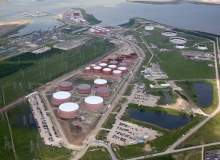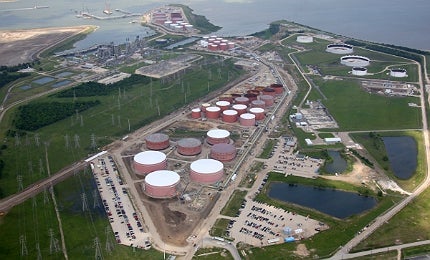

Battleground Oil Specialty Terminal Company (BOSTCO), comprising Kinder Morgan Partners and TransMontaigne Partners, launched the construction of a new black oil terminal facility on the Houston Ship Channel, dubbed as the BOSTCO Project, in December 2011.
Kinder Morgan Partners holds a 55% interest in the project, while the remaining 45% interest is held by TransMontaigne Partners.
An expansion phase to the project was introduced in June 2013. Construction works for the expansion phase commenced in the second quarter of 2013. Initial operations for the first phase started in October 2013, while the phase two expansion was operational by the third quarter of 2014.
The estimated investment on the first and the second phases of the expansion are $425m and $54m, respectively.
The construction was carried out by employing approximately 750 local contractors. The terminal facility employed 75 full-time employees upon the start of operations. The total storage capacity of the terminal is 7.1 million barrels.
BOSTCO Project background
TransMontaigne Partners initially acquired 190 acres of undeveloped land on the Houston Ship Channel in November 2010 to build the terminal.
The design and permitting activities, including initial preparatory works for the project, were carried out in 2010 and early 2011.
The project site covers an area of approximately 185 acres of land and waterfront. The terminal facilitates storage, blending and handling of residual fuel, feedstock, distillates and other black oils.
The products are brought into the terminal via ships, barges and rail cars while exportation of the products is done by ships and barges.
Black oil terminal construction on the Houston Ship Tunnel
The first phase of the project includes 51 storage tanks that have a combined capacity of 6.5 million barrels. It also involved the construction of deep draft docks to enable the largest ships to access the channel. The sizes of the storage tanks vary from 30,000 barrels to 320,000 barrels.
The design incorporates the provision of high-speed pumping rates of 25,000 barrels an hour for loading ships and dock line stripping systems. Dredging and marine construction activities involved the construction of two ship docks and three barge docks with a capacity of handling up to 12 barges. The project also involved the construction of a twin track rail siding to handle the unloading of products from 12 rail cars.
The two docks at the project site are capable of handling large ships with a length of 1,000ft, a beam of 168ft, a draft of 45ft, and displacement tonnage of 205,000 metric tonnes. An electrical substation, bridges and an office building were also constructed as part of the project.
The expansion phase with a capacity of 900,000 barrels added another six storage tanks, each with a capacity of 150,000 barrels. It also included the installation and provision of ultra-low sulphur diesel tanks, additional pipeline, a deepwater vessel dock access, and high-speed loading facilities with a rate of 30,000 barrels an hour.
BOSTCO black oil terminal expansion
Future expansion at the terminal will encompass the third phase of the project. The third phase is expected to add 3.7 million barrels capacity, including new pipeline connectivity.
The terminal will also be served by Highways 225 and 146, and East Sam Houston Tollway in the near future. An additional ship dock will also be constructed, which will provide berthing for two ships and four more barge spots.
The capacity of the rail siding will also be increased to facilitate unloading activities for 30 rail cars. A truck rack to accommodate four trucks will also be provided.
Related content
TransCanada’s Gulf Coast Pipeline Project, Oklahoma, Texas
The 780.5km long Gulf Coast Pipeline is being constructed by TransCanada, a North American energy company based in Calgary, Canada.
Calhoun LNG Project, Texas, United States of America
LNG is one of the major fuels of the future, and the construction of LNG regasification facilities across the world is increasing.




